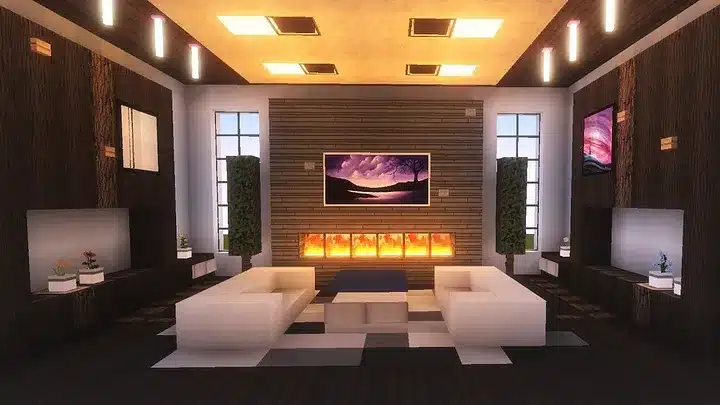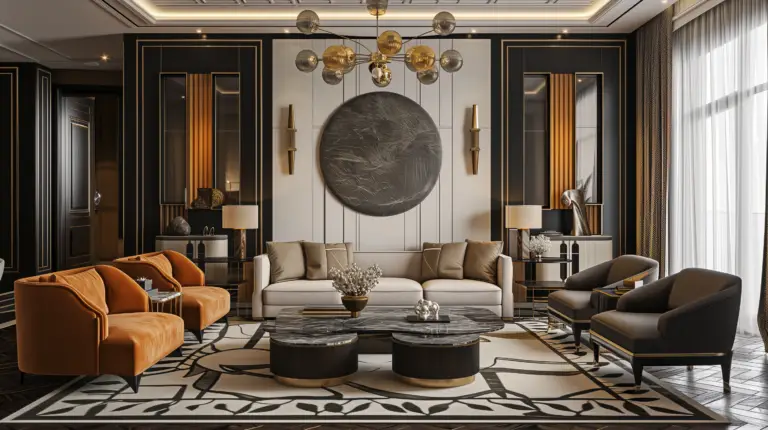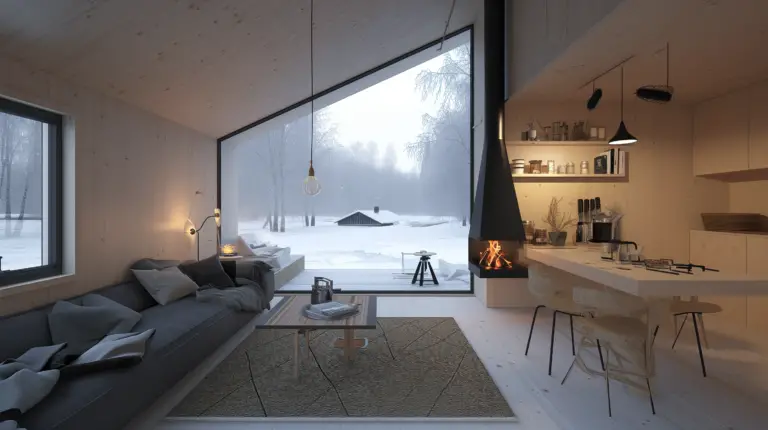Free Shipping On All Orders
2000s Interior Design: 5 Bold Trends That Defined the Decade

As we reminisce about the early 2000s, it’s not just the fashion and pop culture moments that come to mind, but also the distinctive 2000s interior design trends. A time of fusion and experimentation, the 2000s saw the emergence of new styles and concepts that left a lasting impact on the world of interior design. From shabby chic to glamorous revivals, let’s dive into some of the trends and influences that defined this exciting decade in design.
At the turn of the century, one of the key themes dominating interior design was shabby chic. This rustic, slightly distressed style combined country and vintage elements to create a charming, cozy atmosphere in our homes. Ruffled lace bedding, distressed white-washed nightstands, and other shabby chic elements were all the rage in bedrooms and living spaces. But as the decade progressed, newer styles and materials started taking center stage, influenced by the likes of Japanese designers Shin and Tomoko Azumi, who designed the LEM bar stool, which won the Product of the Year title at the FX International Interior Design Awards in 2000.
While not every trend from the early 2000s has endured, their impact is still felt in modern interior design. From the revival of 80s glam to the oversized and textured furniture choices that defined the era, 2000s interior design has laid the foundation for many of the styles and concepts we enjoy today.
Key Takeaways
- Shabby chic was a dominant style early in the 2000s
- Influential designers brought innovative materials and textures to interior design
- Many 2000s trends continue to influence modern interior design styles
Early 2000s Interior Design Trends
The early 2000s were an interesting time for interior design. As a designer during that period, I recall several prominent trends that dominated the scene. In this section, I will discuss four key trends: Minimalism, Neutral Colors, Oriental Influences, and Natural Materials.
Minimalism

During the early 2000s, minimalism became a prevalent force in interior design. The focus shifted to clean lines, simple shapes, and uncluttered spaces. Homeowners embraced the idea of “less is more” and aimed to create peaceful, organized environments. Minimalist designs often featured:
- Open floor plans
- Clean, straight lines
- Monochromatic color schemes
- Simple furniture and decor
Neutral Colors

Neutral colors were another prominent trend in early 2000s interior design. Designers and homeowners alike gravitated towards soft, muted shades like beige, cream, and light gray. These understated color palettes created a soothing atmosphere and complemented the minimalistic aesthetic of the time. Key elements of neutral color schemes included:
- Beige and cream walls
- Light-colored wood flooring
- Soft, subtle accents in decor and textiles
Oriental Influences
Oriental design elements began to make their way into interior design in the early 2000s, adding an exotic touch to even the most minimalistic spaces. These influences often came in the form of fabrics, artwork, and decor, including:
- Silk throw pillows and window treatments
- Asian-inspired artwork and wall hangings
- Bamboo and rattan furniture
Natural Materials

In sync with the minimalistic and Oriental trends, natural materials were also favored in the early 2000s interior design. This trend involved incorporating elements like wood, stone, and plant life into various aspects of a space, promoting a connection to nature. Popular natural materials used during this time were:
- Reclaimed wood furniture and accent pieces
- Stone countertops and flooring
- Indoor plants and greenery
The early 2000s were a fascinating period in interior design. As a designer during that era, I embraced the trends of minimalism, neutral colors, oriental influences, and natural materials, creating spaces that reflected a calm, uncluttered, and nature-infused aesthetic.
Key Theme: Shabby Chic
The early 2000s interior design trend experienced a significant trend known as shabby chic. This style of decorating blended vintage and cottage elements in soft, romantic colors and textures, creating an elegant yet worn and welcoming look. Having risen to popularity in the late 1980s, shabby chic continued to be a favorite in 2000s interior design.
I remember how shabby chic was characterized by its delicate white and pastel color palette. The style predominantly featured shades of white, from ivory to cream and chalky hues. These light colors were key in setting the tone for a soothing and inviting atmosphere.
In addition to the color palette, shabby chic in the 2000s emphasized the use of distressed and vintage furniture pieces. This added a sense of rustic charm and history to each space while avoiding a feeling of being overly polished or artificial. Soft and natural textures, such as linens and cotton, were also essential for creating the cozy and comfortable ambiance associated with this design motif.
Not to be mistaken for farmhouse style, which came later, shabby chic incorporated a French country vibe, though both styles shared some similarities. They both focused on rustic and lived-in elements. However, shabby chic set itself apart with its softer colors, distressed furniture, and romantic flair.
When reflecting on the early 2000s interior design, the shabby chic trend certainly stands out as a key theme that contributed to the distinctive look of the decade. As a designer, I embraced the delicate and welcoming qualities of this style, appreciating how it enhanced the warmth and character of many homes during that time.
Mid-2000s Styles
Retro Revival

During the mid-2000s, interior design experienced a retro revival. I noticed that many designers and homeowners became fond of reinterpreting styles from the past, especially from the 1950s, 1960s, and 1970s. This trend manifested itself in various ways, such as:
- Using bold, geometric patterns like chevron or houndstooth
- Incorporating retro furniture pieces with tapered legs, curved lines, and tufted upholstery
- Utilizing vintage decorative items, like old-school telephones or classic movie posters
The retro revival enabled individuals to personalize their spaces while paying homage to previous generations.
Sustainable and Eco-Friendly Design
Another notable trend I observed in mid-2000s interior design was a growing emphasis on sustainability and eco-friendliness. More people became concerned about the impact their homes had on the environment, prompting designers to consider alternative materials and energy-efficient solutions. Some of the key aspects of sustainable design during this period included:
- Reclaimed and recycled materials: Designers started using reclaimed wood, recycled glass, and other repurposed materials to create unique and eco-friendly pieces.
- Energy-efficient lighting: The popularity of compact fluorescent lamps (CFLs) and light-emitting diode (LED) bulbs increased, as they offered efficient alternatives to traditional incandescent bulbs.
- Indoor plants: Many homeowners included plants in their interiors to improve air quality and bring a touch of nature into their spaces.
Sustainable and eco-friendly design not only contributed to a healthier environment but also added an inviting, organic element to homes in the mid-2000s.
Popular Materials and Textures
In the 2000s, interior design saw the rise of various materials and textures that became popular choices in many homes. Today, I’ll be focusing on two notable trends: stainless steel and glass surfaces.
Stainless Steel
Stainless steel became a staple material in 2000s interior design, particularly in kitchens. Its sleek and durable nature made it a popular choice for various elements, such as appliances, countertops, and backsplashes. The elegant appearance of stainless steel paired well with the minimalist aesthetic that was prevalent during this decade.
- Appliances: Stainless steel fridges, ovens, and dishwashers lent a high-end look to many kitchens.
- Countertops: This material provided a durable and easy-to-clean surface for meal prep and cooking.
- Backsplashes: Stainless steel backsplashes added a cohesive and modern touch to kitchens.
Glass Surfaces

In addition to stainless steel, glass surfaces emerged as a popular trend in 2000s interior design. They provided a clean and sleek look that worked well with the modern aesthetic of the time. Glass was commonly used in furniture, partitions, and even wall treatments.
- Furniture: Glass-top tables, both in dining and coffee table varieties, made a statement in many homes with their minimalist appearance.
- Partitions: Glass room dividers allowed for open concept living while still providing some separation and privacy.
- Wall Treatments: Some homeowners opted for glass tile backsplashes, especially in contemporary kitchens and bathrooms, giving a clean and stylish appearance.
By incorporating stainless steel and glass surfaces in their designs, homeowners in the 2000s were able to achieve a sleek, modern aesthetic that was cutting edge and stylish during that time.
Influential Designers of the Era
In the 2000s, several interior designers played a significant role in shaping the design trends of the era. Among them, Japanese designers Shin and Tomoko Azumi designed the LEM bar stool, which won the Product of the Year title at the FX International Interior Design Awards in 2000. This simple and elegant creation embodied the design principles many interior designers adhered to during the 2000s.
Another influential figure from the era is Billy Baldwin. Although his peak was during the 1950s and 1960s, his design principles, including clear colors, crisp patterned cotton, and sophisticated décor with minimal clutter, continued to influence designers in the 2000s. The natural wood tones popular during the ’90s persisted in the 2000s, drawing inspiration from Baldwin’s approach.
The 2000s also saw the revival of 80s glam in interior design, which provided a creative reimagination of earlier design trends while adapting to the changing times. This shift in design philosophy was marked by a fondness for nostalgia and a tendency to blend elements from various eras. Designers of the time merged contemporary sensibilities with a nod to the past, resulting in a rich blend of design ideas.
I believe these interior designers and design movements from the 2000s fueled the evolution of the industry and left a lasting impact on how we perceive and understand design today.
Impact of 2000s Design on Modern Interior Design
I’ve noticed that the 2000s interior design had a significant impact on today’s modern design. A blend of minimalism from the 90s with added colors and personal touches created a unique, comfortable atmosphere in homes during the 2000s. Many aspects of this design era can still be observed in contemporary spaces.
In the beginning, I observed that the 2000s design was heavily influenced by the minimalism movement. Many homeowners during this time focused on decluttering their spaces and incorporating simple, clean elements into their homes. This minimalist approach is still prevalent today, as modern designs often prioritize functionality and simplicity.
The 2000s also brought a revived appreciation for natural wood, rejecting the excess of previous decades. This shift towards natural, raw materials can still be seen in modern interior designs. Nowadays, it’s common to find homes featuring natural wood accents and furniture, highlighting the warmth and organic feel these materials offer.
Additionally, I saw that the 2000s design was characterized by an eclectic mix of styles. This creative blending of old and new is a trademark of today’s modern interior design. Many designers, including myself, enjoy combining pieces from different eras with contemporary elements to create unique spaces that reflect our clients’ personalities.
Furthermore, I found that the introduction of bold colors and personal touches in the 2000s was another way homeowners made their spaces feel more homely and distinct. This personalization trend has continued to evolve with modern designs featuring custom artwork, statement furniture pieces, and personalized accents.
In conclusion, I can confidently say that the 2000s interior design has left a lasting impression on modern design. With the incorporation of natural materials, minimalism principles, and creative blending of styles, the 2000s have paved the way for today’s comfortable, functional, and personalized interior spaces.
Frequently Asked Questions
What were the popular design trends of the 2000s?
Open floor plans, minimalist furniture, and neutral color schemes were popular in the early 2000s, while bold colors, graphic prints, and retro-inspired designs gained traction later in the decade.
What are some iconic pieces of 2000s interior design?
The Louis Ghost chair, Philippe Starck’s Juicy Salif citrus squeezer, and the Noguchi coffee table are some of the most iconic pieces of 2000s interior design.
How has interior design changed since the 2000s?
Interior design has become more personalized and eclectic, with a focus on sustainability and natural materials. Technology has also played a larger role in design, with smart home features and virtual reality tools becoming more common.
If you liked this post about 2000s interior design, don’t forget to follow us on Pinterest so you don’t miss any more interior design news!






